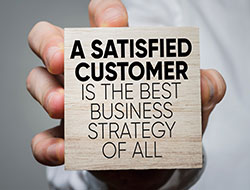09.16.20 By Molly Redenbaugh

Now, more than ever, it seems the world wants to know what customers are thinking. Maybe this increased interest in customer perspective is a result of limited human interaction in our COVID-dominated world? Maybe the trendy topic of customer experience is finally being taken seriously? (Hey, a girl can hope!) Regardless of the reason, a recent spike in conversations regarding surveying customers has me wondering. Why, in our world of big data and digital transformation, is this antiquated method of data collection still the “be all, end all” for the voice of the customer.
It’s as if no one seems to know what customers are thinking without a survey. Haven’t we all been on the receiving end of a “business rule” implemented for internal reasons without reviewing the impacts to customers? Haven’t we seen archaic, internally focused tools that should have been replaced decades ago, yet they remain primarily as a barrier to customer success? Haven’t we fallen victim to businesses’ performance metrics that are in direct conflict with successful outcomes for customers? And my personal favorite, “we need to train our customers”! If your organization has used this phase, this article is for you.
Let’s look at the downfall of customer surveys in general. In this example, a marketing department of a large organization wants to capture the “voice of the customer.” What a fantastic idea! Customers will tell us what they think about how we did, about where we can improve, and the world will be a glorious place!! Cue angels singing…
“Oh! And,” the management interjects “we can tie bonuses to those surveys so when our people are doing amazing things, we can reward them. We have the data, and we are going to put that data to good use.” Matrix Marketers tell me this isn’t the project you pitched to leadership?
Now comes the tricky part. Someone in the chain of command is given a hefty bonus for a perfect score. To ensure that he gets that bonus, he instructs the team that anything less than a 10 is a failure. This leads to the car lot conversation with your sales team member of “You will get a survey in a few days asking about your experience, anything less than a 10 means we failed, so please let me know how I did so I can fix it and you can give us a 10 for our efforts”
Complete customer experience failure! Regardless of how well-intentioned the survey was, it has been sidelined by competing KPIs and in most cases, the marketing team still believes they are the best at what they do because all the customer surveys say they are doing great!
How can we take the example above and make it better? We all buy things; we all know what we personally think is a great experience. So why not use those same expectations at work? What kind of experience would you want if you were your customer?
First, it’s important to look at your customer needs. Are you delivering to the customer’s desired outcomes? How does every interaction with the customer  work toward achieving that goal? Do your internal metrics drive customer satisfaction or only measure throughput? How does a score of “10” build loyalty and deliver confidence, would a “9” not do the same? Have you changed the entire experience for the customer by misplacing the incentive? What emotions do customer feels about the ask, even if their experience was excellent?
work toward achieving that goal? Do your internal metrics drive customer satisfaction or only measure throughput? How does a score of “10” build loyalty and deliver confidence, would a “9” not do the same? Have you changed the entire experience for the customer by misplacing the incentive? What emotions do customer feels about the ask, even if their experience was excellent?
A personal connection was established between customer and salesperson, up until the point the salesperson’s motivation was displayed. Imagine the doubt a customer would have about the integrity of the salesperson, and the last interaction of the experience being the worst part of the experience. Your survey has not only silenced the voice of the customer but has now impacted the buyer’s experience and prohibited loyalty and confidence.
Second, let’s align KPIs to the customer’s outcome. As I like to say, “people get really clever at delivering the things they are measured against.” If you must ask for a customer opinion, don’t tie bonuses to it. After all, they are just a reflection of what happened in the past. One technique may be for the team member to capture the customer’s sentiment during the event – a proactive technique used by many of the world’s greatest customer experience organizations.
On a related note, did you know your survey outcomes are often dependent on the survey takers mood? If they are in a bad mood, you get a lower score, but if they are in a good mood, you get a higher score. If you send it on a Friday, you will probably get a lower response rate, but you may get a higher score. And whatever you do, don’t send it around the holidays, because no one has time for that. Seriously, wouldn’t it just be easier to know you are actually delivering a positive experience rather than jumping through all these hoops?
The purist in me says “Yes!! Do it now! Don’t wait another minute!” The realist understands many companies have a long way to go before taking this leap.
Being by ensuring your customer experience is outcome driven. By understanding the desired outcome, you can deliver positive outcomes repeatedly. In this brave new world, you will also drive a reduction in organizational complexity that has accumulated over the years. Business rules and processes put in place years ago are most likely no longer needed and have simply become a barrier for customers to purchase your product or service.
Follow this step by aligning KPIs with successful customer outcomes and align your organizational incentives to those metrics. Your organization will be driven toward achieving successful outcomes for your customer. After all, we live in a world where retailers know what we want, before we know we want it. It’s time to be proactive, even predictive, in our experience measures.
Initiatives such as these drive experiences that can be measured, improved and refined throughout an organization. Best of all, your organization will never be surprised by a C-SAT score again.
Want to align your processes to achieve customer-centric outcomes? Let’s connect.